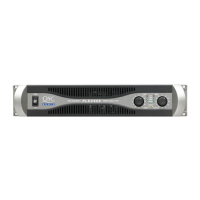T r o ubleshooting
PLX 1202 l PLX 1602 l PLX 2402 l PLX 3002
Power Supply
-
-
Replacing Blown
IGBTs.
In order to improve
EMI
performance, reduce cost, and increase current capacity, the PLX
IGBTs
are driven by an active, direct coupled integrated circuit, rather than a gate drive transformer.
IGBT
or
driver failure should be rare (when correctly assembled) but when the
IGBT’s
blow, it usually damages the
following parts:
CHECKLIST AFTER BLOWN
IGBT’S
Q96, Q97,
(IGBT’s
generally fail in pairs)
D78, D79,
R358,
R359,
gate drive coupling
comonents,
check after removing blown
IGBT’s.
Ul8,
lR2110
high-side gate driver, Fault current when low-side
IGBT
shorts to upper rail. Such currents
also typically damage the gate coupling parts noted above.
Ul9,
3525 controller, Blows from currents shorted
thru
Ul8,
or possibly by overvoltage on the supply rail
SOMETIMES
Ul4,
556,
powered from
5V
output of 3525, which may fail high when 3525 fails.
RARELY
Ul3,
which has fairly high supply voltage ratings.
PROBABLE CAUSES OF MASSIVE
IGBT
FAULTS
SHORTS IN CONTROL CIRCUIT.
The parts operate well within their ratings and should hold up well in the field. The usual cause of failure is
when both
IGBT’s
turn on at once, shorting Pri-Hi to Pri-Lo. This occurs when something causes the drive
signal to one part to remain on when the other part is supposed to turn on. Shorts from solder or debris are
one obvious cause.
SHORTS IN THE LOAD.
Although there is peak current shutdown, shorts in the power amplifier transistors or secondary-side supply
components can cause currents to increase too quickly to prevent damage.
OVERVOLTAGE ON THE BIAS SUPPLY.
If the TOP-210 bias supply fails to operate, no harm occurs, the unit simply does not operate.
However, open circuit (missing part) in several key components can cause the Bias supply voltage to be
much too high, This blows the 2110 and thus the
IGBT’s.
QUICK TEST OF BIAS SUPPLY.
Ramp the AC voltage up slowly to 25% of regular voltage (30V for
12OV
unit). If the bias supply is working
normally, the green “power” LED should come on between 30 and
35Vz
with its usual, steady
“half-brighr
start-up level. If the LED comes on at
2OV,
or not until
5OV,
or blinks, DO NOT RAISE VOLTAGE PAST 60V
until you have measured the bias voltage. The switching will not start until you reach
9OV,
so you can save
the
IGBT’s
from blowing.
Confirm that bias voltage at Cl38 is
18-19V.
Open or missing
D63,
64, 65, 66, 67 or R349 will break the
feedback to U16 and cause overvoltage.
13

